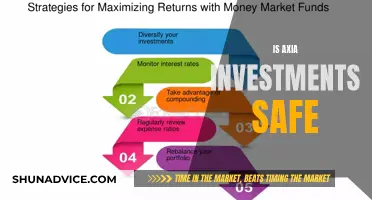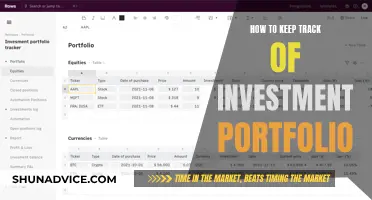
Building an investment portfolio can be a challenging task, but it is a vital financial skill for active investing. A portfolio is a collection of financial investments such as stocks, bonds, commodities, cash, and cash equivalents. It is important to diversify your portfolio to reduce risk and maximise returns.
There are several steps to building an investment portfolio. First, you need to determine your financial goals and risk tolerance. Second, you need to choose the types of assets you want to include in your portfolio, such as stocks, bonds, mutual funds, or exchange-traded funds (ETFs). Third, you need to decide how much of each asset to include, based on your risk tolerance and investment objectives. Fourth, you need to regularly monitor and rebalance your portfolio to ensure it remains aligned with your goals and risk tolerance.
It is also important to remember that investing should be a long-term strategy, and that returns are not guaranteed.
| Characteristics | Values |
|---|---|
| Purpose | Generate income or capital appreciation |
| Assets | Stocks, bonds, cash, real estate, commodities, cash equivalents, exchange-traded funds (ETFs), mutual funds, certificates of deposit (CDs), savings accounts, etc. |
| Risk Tolerance | Depends on the investor's age, financial goals, and personality |
| Time Horizon | Short-term (less than 1 year), medium-term (1-5 years), or long-term (more than 5 years) |
| Diversification | Spread investments across different asset types, industries, and companies to reduce risk |
| Tax Exposure | Consider tax-advantaged accounts (e.g., 401(k), IRA) and taxable brokerage accounts |
| Monitoring and Rebalancing | Regularly review and adjust the portfolio to maintain the desired asset allocation |
What You'll Learn

Know your objectives
Before you start investing, it's important to know what you want to achieve. This may seem obvious, but it's easy to overlook. Most people invest with the goal of improving their financial future and providing an income for retirement. However, you may also have other milestones in mind, such as building a house deposit or saving for your children's education. Knowing your objectives will give you a clear picture of your investment time horizons and the level of returns you're aiming for. This, along with your risk appetite, will help shape the overall risk profile of your portfolio.
Your investment strategy should be tailored to your objectives and risk appetite, aiming to achieve the best return for your chosen level of risk. A well-diversified portfolio is your best bet for consistent long-term growth. Diversification is a key concept in portfolio management, reducing risk by allocating investments across various financial instruments, industries, and other categories. It's important to remember that diversification should be maintained above all else. You must diversify not only across different asset classes but also within each class, spreading your holdings across an array of subclasses and industry sectors.
When constructing a portfolio, it's crucial to consider your individual financial situation and goals. Factors such as age, investment time horizon, capital to invest, and future income needs will influence your investment strategy. For example, a 22-year-old college graduate starting their career will require a different strategy from a 55-year-old planning to retire within the next decade. Your personality and risk tolerance also play a significant role. Ask yourself if you're willing to risk potential losses for the possibility of greater returns. If short-term drops in your investments cause you stress, a more conservative approach may be more suitable.
Clarifying your current situation, future capital needs, and risk tolerance will determine how your investments should be allocated among different asset classes. Generally, the more risk you can bear, the more aggressive your portfolio will be, with a larger portion devoted to equities. Conversely, if you assume less risk, your portfolio will be more conservative, focusing more on bonds and other fixed-income securities.
Savings and Investments: Strategies for Success in Lean Times
You may want to see also

Choose your risk level
Choosing your risk level is a critical step in building an investment portfolio. It is important to understand your risk tolerance, which is your ability to accept potential losses in the hope of higher investment returns. Your risk tolerance is influenced by your financial goals, time horizon, and mental comfort with market fluctuations.
- Financial Goals: Determine your short-term, medium-term, and long-term financial goals. For example, saving for a car in the short term, a house in the medium term, and retirement in the long term. Each goal will have a different time horizon, impacting your risk tolerance.
- Time Horizon: Consider how much time you have before achieving each financial goal. A longer time horizon generally allows for a more aggressive risk level, as you have more time to recover from potential losses. For instance, a young investor saving for retirement can afford to take on more risk than someone nearing retirement.
- Risk Tolerance: Assess how comfortable you are with market volatility. Some people are comfortable with short-term losses in pursuit of higher returns, while others prefer a more conservative approach to avoid significant losses. Your mental tolerance for risk plays a crucial role in choosing your risk level.
- Personality: Evaluate your personality traits and how they align with different risk levels. Are you comfortable taking on greater risk for the potential of higher returns, or do you prefer a more stable and secure investment strategy? Your personality can help guide your decision.
- Age and Life Stage: Your age and life stage play a significant role in determining your risk level. A young college graduate starting their career can afford to take more risk than someone closer to retirement. Life events such as marriage, parenthood, and retirement should also be considered when choosing your risk level.
By considering these factors, you can choose a risk level that aligns with your financial goals, time horizon, and personal comfort. Remember, it's important to regularly review and adjust your risk level as your circumstances change over time.
Building an Investment Portfolio: A Comprehensive Guide
You may want to see also

Select your investments
The types of investments you choose will depend on your risk tolerance, goals, and time horizon. Here are some common types of investments:
- Stocks: Stocks are a tiny slice of ownership in a company. Investors buy stocks that they believe will go up in value over time. Stocks tend to be a higher-risk investment but also offer a greater chance of growth than bonds or cash alternatives.
- Bonds: Bonds are loans to companies or governments that get paid back over time with interest. They are considered safer investments than stocks but generally have lower returns.
- Mutual funds: Mutual funds are baskets of securities that allow you to invest in a diverse range of stocks or bonds at once. They are less risky than investing in individual stocks but usually come with management fees.
- Index funds and ETFs: These investments try to match the performance of a market index and are passively managed, resulting in lower fees than actively managed funds. ETFs are similar to mutual funds but trade like stocks and can be actively traded on an exchange.
- Alternative investments: You can also invest in precious metals, real estate, cryptocurrencies, hedge funds, commodities, and other alternative investments to diversify your portfolio. However, these options tend to be higher risk than stocks and bonds.
- Cash and cash alternatives: Investments like savings accounts, money market funds, and certificates of deposit (CDs) offer low-risk ways to set aside cash and earn a modest rate of return.
When selecting your investments, it's important to consider your risk tolerance and investment goals. Younger investors with a higher risk tolerance and a longer time horizon may opt for more aggressive portfolios with a larger portion of equities. On the other hand, older investors with a lower risk tolerance and a shorter time horizon may prefer more conservative portfolios with a higher allocation of bonds and other fixed-income securities.
Additionally, diversification is key to managing investment risk. By spreading your investments across different asset classes, industries, and companies, you can reduce the impact of losses in any one area. This can be achieved through mutual funds, ETFs, or by investing directly in a diverse range of individual stocks and bonds.
Strategically Diversifying Your Investment Portfolio: A Smart Investor's Guide
You may want to see also

Diversify your portfolio
Diversifying your portfolio is a great way to reduce risk and ensure your investments are protected from financial disruptions. Here are some tips to help you diversify your investment portfolio:
Learn Why Diversification is a Must
Diversification is essential because it helps to reduce the overall risk of your investments. By spreading your investments across different industries, sectors, and asset classes, you can lower the impact of any single investment performing poorly. Diversification is not just about the types of investments you choose but also about diversifying within each class of security. For example, instead of investing all your money in the pharmaceutical sector, consider spreading your investments across other sectors like education technology or information technology.
Asset Allocation
The basic types of investments are stocks and bonds. Stocks are typically considered high-risk, high-return investments, while bonds are more stable and offer lower returns. To diversify your portfolio, you should divide your money between these two options to minimise risk. A good rule of thumb for asset allocation is to subtract your age from 100 – this should be the percentage of stocks in your portfolio. For example, a 30-year-old could allocate 70% of their portfolio to stocks and 30% to bonds. As you get older, you may want to reduce your risk exposure by adjusting the stock-to-bond allocation to 40:60. However, it's important to consider your family finances and expenses when making these decisions.
Assess the Qualitative Risks of Stocks Before Investing
You can use qualitative risk analysis to minimise the unpredictability of stock transactions. Evaluate stocks based on parameters such as business model robustness, management integrity, corporate governance, brand value, compliance with regulations, risk management practices, and the dependability of their products or services.
Invest in Money Market Securities for Cash
Money market instruments, such as certificates of deposit (CDs), commercial papers (CPs), and treasury bills (T-bills), offer a safe and easily liquidated investment option. Treasury bills, in particular, are considered close to risk-free as they are backed by the central government and insulated from market fluctuations. While they may not offer high returns, they are ideal for short-term investments or offsetting riskier investments.
Invest in Bonds with Systematic Cash Flows
Mutual funds offer a reliable and stable investment option. If you want access to your money while it is locked in a savings plan, consider investing in mutual funds with systematic cash flow or a systematic withdrawal plan (SWP). This allows you to withdraw a fixed amount monthly or quarterly. Alternatively, you can use a systematic transfer plan (STP) to maintain a balance in your portfolio by transferring a fixed amount between mutual funds.
Follow a Buy-and-Hold Strategy
Instead of constantly trading, consider a more passive approach by holding onto your investments for the long term. This strategy allows your investments to grow over time, but it's important to periodically review and adjust your portfolio to ensure it aligns with your goals and risk tolerance.
Understand Factors that Impact the Financial Markets
Before investing, it's crucial to understand the factors that influence financial markets, such as interest rates, inflation, and the monetary policies of central banks.
Learn about Global Markets
Global markets offer the potential for high returns in a short period, but they come with additional complexities, such as multiple monetary regulations and fast-moving dynamics. Consider starting with an exchange-traded fund (ETF) or a mutual fund with low costs and ample liquidity to dip your toes into the global market.
Rebalance Your Portfolio Periodically
It's important to periodically check the balance of various assets in your portfolio and make adjustments as needed. This review should be based on your goals, life milestones, and the performance of your investments over time. A financial advisor can help you with this process and provide guidance on available investment options.
Try a Disciplined Investment Scheme
If you have a small amount to invest over time rather than a large sum at once, consider a systematic investment plan (SIP). With a SIP, you can invest a fixed amount in mutual funds at regular intervals. This approach helps instil discipline in your investment strategy and is ideal for young investors or those who want to invest small amounts each month.
Invest in Life Insurance
Life insurance is often overlooked by young adults, but it is a crucial investment avenue, especially when you are young and can take advantage of lower premium rates. Life insurance will protect your loved ones in the event of your death, and you can also invest in unit-linked insurance plans (ULIPs) to combine life insurance with market-linked investments.
Be Aware of Your Financial Biases
When planning your investments, be mindful of external factors and prejudices that may influence your decisions. These include risk aptitude, family attitude, luck, and cultural beliefs. For example, your family background and cultural attitudes may impact your willingness to take risks, with well-off families more likely to opt for high-risk, high-return investments.
By following these tips, you can effectively diversify your investment portfolio, minimising risk and maximising the potential for long-term growth.
Investment Portfolio Strategies for a Comfortable Retirement
You may want to see also

Monitor and adjust
Monitoring and adjusting your investment portfolio is a critical aspect of achieving your financial goals and managing risk effectively. Here are some detailed steps to help you monitor and adjust your portfolio:
Regularly Review Your Portfolio:
- Set a schedule for reviewing your investment portfolio, such as twice a year or at specific intervals. This allows you to ensure that your asset allocation remains aligned with your goals and risk tolerance.
- Keep track of market volatility and economic trends that may impact your investments. Stay informed about changes in the performance of individual holdings and the overall market.
Rebalance Your Portfolio:
- Over time, the value of your investments in different asset classes may deviate from your desired allocation. Rebalancing involves buying or selling certain assets to return your portfolio to its original weightings. For example, if your portfolio has become overweight in stocks, you may sell some stocks and reinvest the proceeds in bonds or other asset classes.
- Consider the tax implications of selling assets when rebalancing. In some cases, you may decide to adjust your future contributions instead of selling assets to avoid capital gains taxes.
Adjust Your Strategy as Life Changes:
- Monitor your portfolio closely during significant life events, such as marriage, divorce, having children, receiving an inheritance, or approaching retirement. These events may require you to re-evaluate your investment strategy and make adjustments to align with your new circumstances.
- As your life stage changes, your risk tolerance and financial goals may also evolve. For example, as you get closer to retirement, you may want to shift your portfolio towards more conservative assets like bonds to protect your savings.
Maintain Diversification:
- Diversification is a key principle in portfolio management. Ensure that your portfolio remains diversified across different asset classes, industries, and companies. Diversification helps to reduce risk and maximize returns by spreading your investments among various financial instruments.
- Regularly assess the diversification of your portfolio and make adjustments as needed. This may involve investing in new asset classes, sectors, or companies to maintain a well-diversified portfolio.
Seek Professional Advice:
If you feel overwhelmed or uncertain about monitoring and adjusting your portfolio, consider seeking advice from a financial adviser or a robo-advisor. They can provide personalized recommendations based on your goals, risk tolerance, and market conditions.
Savings Strategies: Where to Invest for Maximum Returns
You may want to see also
Frequently asked questions
An investment portfolio is a collection of financial investments such as stocks, bonds, commodities, cash, and cash equivalents. It can also include real estate, art, and private investments. The idea is to diversify your investments to reduce risk and maximise returns.
First, determine your financial goals and risk tolerance. Then, decide on the types of investments you want to include in your portfolio (e.g. stocks, bonds, mutual funds, etc.). You can do this yourself or seek the help of a financial advisor.
This depends on your risk tolerance and financial goals. If you are willing to take on more risk, you may want to invest more in stocks, which tend to have higher returns but also come with higher risk. If you are more risk-averse, you may want to invest more in bonds, which provide a steady income with lower risk.
It is important to regularly monitor and rebalance your portfolio to ensure it aligns with your goals and risk tolerance. This may involve buying or selling certain investments to adjust their weightings in your portfolio.
Asset allocation is a strategy for investing, where you decide on the target allocation for each type of investment, sector, and geography. This helps to manage risk and smooth out the ups and downs of the market. Diversification is a key component of a successful investment portfolio.







